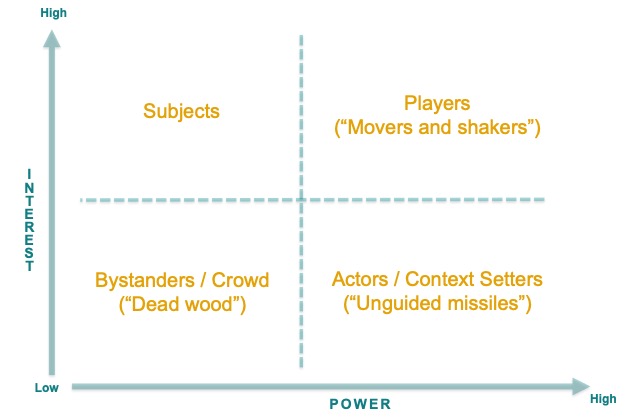4. stakeholder analysis
Stakeholders are individuals and organisations that can influence an issue (problem, decision) or that can be influenced by the issue (problem, decision). Stakeholder analysis is the process of listing, classifying and assessing the influence of stakeholders and can include examination of power, interests, roles and other characteristics of the involved actors.
At a glance
Goal
Definition of actors that can affect, or can be affected by, the problem (i.e. stakeholders).
Input
Problem orientation + system boundaries
Methods
Power-interest analysis, analysis of actor roles, constellation analysis.
Relative workload
Higher
Output
List of stakeholders, P/I-grid, plan for stakeholder involvement (if applicable).
Steps
1. Identify stakeholders.
2. Map the stakeholders according to their level of interest and power to influence a given problem using a power-interest plane.
3. Identify potential conflicting and common interests among the stakeholders for further consensus-building exercises.
Consider questions such as:
Based on Ackermann and Eden (2011):
- Who performs the stakeholder analysis? It is important to position yourself and your goal, as well as the system boundaries.
- What is the goal of the stakeholder analysis?
- What are the system boundaries and how do these boundaries influence what stakeholders can be considered?
Additional questions
- For profit driven stakeholders: What is the core business? Is or will there be any impact in relation to this business stemming either from the problem identified in the Problem orientation module, or from any changes implemented within the sociotechnical system under study in response to this problem? Is the management aware of this?
- For interest groups and similar, focusing on mitigating or resolving certain issues: Is the problem under study at the heart of the organisation’s main issue of interest? Could the problem under study have a more indirect impact also on the issue of main interest for the organisation? In what way?
Power-interest analysis
The power-interest analysis is a simplified approach widely used in strategic management. The power of each stakeholder is indicated on the x-axis of a grid, and the interest of the stakeholder on the y-axis. In this case, the interest refers to the stakeholder’s interest in the matter as a whole – whether it is supportive or might oppose change – and not in relation to a particular change.
Typical challenges of stakeholder analysis (Ackermann and Eden, 2011):
- Due to time limitations, probably not all stakeholders can be included in the analysis. Therefore, a manageable number of key (specific, unique and significant) stakeholders needs to be defined.
- Initially identified stakeholders might need to be further disaggregated into more specific groups. The opposite might also apply, namely that some stakeholders can be aggregated into more general groups.
- It is important to acknowledge and manage ”potential conflict stemming divergent interests” (Frooman, 1999).

Data collection
Certain types of formal power is governed by official decisions and outlined in associated documents. Informal power can be more challenging to assess…
Similarly, a stakeholder’s interest in a matter can be more or less explicit. A problem or a change within the sociotechnical system can have a direct impact on the core business or interest of a stakeholder, but it may also have more indirect implications. A stakeholder may have publicly available documents or other text sources suggesting what their level of interest is in different matters.
For more information about data collection, see participation and context.
Participatory elements
Since a main part of this module is focused on identifying and assessing the power and interest of each actor, deliberate interaction with the relevant stakeholders can provide key information. Stakeholders can not only provide information and insights regarding their own roles (in terms of power and interest) but also regarding the perceived power and interest of other stakeholders.
For more information about participatory elements, see participation and context.
Examples
Example of stakeholders in the heating sector includes:
- Heat generation companies
- Heat distribution network operators
- Local authorities
- Environmental NGOs
- Associations of apartment owners
- Individual consumers of different heating solutions
- Researchers from various fields (such as engineers and social scientists)
- Actors from connected sectors (e.g. smart grid or smart energy sectors)
Make sure to also consider new actors, such as “prosumers” (a stakeholder that both produces and consumes).
Further reading
- Freeman, R. E., 1994. The politics of stakeholder theory: Some future directions. Business ethics quarterly, 409-421.
- Freeman, R. E., Harrison, J. S., Wicks, A. C., Parmar, B. L., & De Colle, S., 2010. Stakeholder theory: The state of the art. Cambridge University Press.
- Bryson, J. M., 2004. What to do when stakeholders matter: stakeholder identification and analysis techniques. Public management review, 6(1), 21-53.
- Mitchell, R. K., Agle, B. R., & Wood, D. J., 1997. Toward a theory of stakeholder identification and salience: Defining the principle of who and what really counts. Academy of management review, 22(4), 853-886.
- Arnstein, S. R., 1969. A ladder of citizen participation. Journal of the American Institute of planners, 35(4), 216-224.
